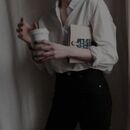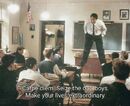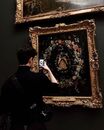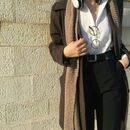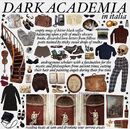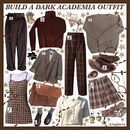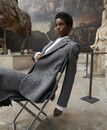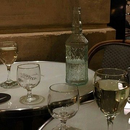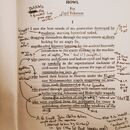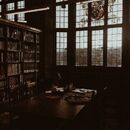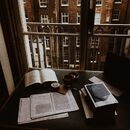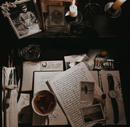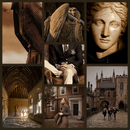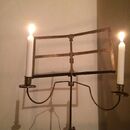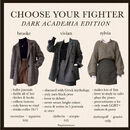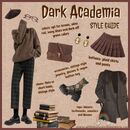Tag: Source edit |
Tag: Source edit |
||
| (12 intermediate revisions by 4 users not shown) | |||
| Line 11: | Line 11: | ||
'''Dark academia''' is a popular [[:Category:Academia|academic]] aesthetic that revolves around classic literature, the pursuit of self-discovery, and a general passion for knowledge and learning. It is one of several variations, each with a unique subject focus. Dark academia's best-known visual variations stem primarily from European cultures. |
'''Dark academia''' is a popular [[:Category:Academia|academic]] aesthetic that revolves around classic literature, the pursuit of self-discovery, and a general passion for knowledge and learning. It is one of several variations, each with a unique subject focus. Dark academia's best-known visual variations stem primarily from European cultures. |
||
| + | |||
| + | Evoking the lifestyle of Romantic-era nobles and intellectuals is the primary goal of Dark Academia. |
||
People who use this aesthetic are usually referred to as dark academics. |
People who use this aesthetic are usually referred to as dark academics. |
||
| Line 24: | Line 26: | ||
Dark academia focuses predominantly on languages, literature, architecture, art, poetry and fashion originating from Western Europe and has been consequently criticized as Eurocentric. Many dark academics have rejected an exclusionary interpretation of dark academia and encouraged academics to include non-Western languages, literature, architecture, and clothing in their conceptions and use of the aesthetic.<ref>https://sappylittlebitch.tumblr.com/post/620401404176154624/cultural-dark-academia</ref><ref>https://punkenglishnerd.tumblr.com/post/189453466668/to-all-the-people-saying-can-i-still-be-a-dark</ref><ref>https://ataphya.tumblr.com/post/645623340466339840/also</ref> |
Dark academia focuses predominantly on languages, literature, architecture, art, poetry and fashion originating from Western Europe and has been consequently criticized as Eurocentric. Many dark academics have rejected an exclusionary interpretation of dark academia and encouraged academics to include non-Western languages, literature, architecture, and clothing in their conceptions and use of the aesthetic.<ref>https://sappylittlebitch.tumblr.com/post/620401404176154624/cultural-dark-academia</ref><ref>https://punkenglishnerd.tumblr.com/post/189453466668/to-all-the-people-saying-can-i-still-be-a-dark</ref><ref>https://ataphya.tumblr.com/post/645623340466339840/also</ref> |
||
| + | <br /> |
||
| − | Latin, ancient Greek, English, and French are popular in dark academia both as subjects of linguistic study and in aesthetic images of text. Gothic, Renaissance, Baroque, and Neoclassical architecture are featured frequently in dark academic images.<br /> |
||
== Visuals == |
== Visuals == |
||
| + | Dark Academia as a whole utilizes the colors black, dark brown, forest green, dark orange, cream, gold, and burgundy. The photographs also tend to be dimly lit, as to give the appearance of illumination through only candle light, a sun-less day, or light being unable to reach the interiors of a deep, alcove-filled room. As such, chiaroscuro, the contrast between light and dark, is a common motif within images and outfits. White statues in the dark, pale skin (see Eurocentricism) contrasting dark clothing, and the art movements described below are examples of this style. Often, photo editing is employed to increase the shadows of the image. |
||
| + | The artworks utilized in Dark Academia come from the periods typically associated with European civilization: Renaissance, [[Baroque]], [[Classicism|Neoclassical]], Academic, Romantic, Aesthetic, and Pre-Raphaelite periods are the paintings that are the most commonly reblogged, with subjects such as anatomical studies, vanitas, Christian and Classical mythology, and portraiture of people wearing clothing in the Dark Academia colors. |
||
| − | * Antique books |
||
| − | * Art museums, with people interacting and viewing the art |
||
| − | * Blood, poison, and other murder imagery |
||
| − | * British estates, especially oak-paneled rooms |
||
| − | * British moors |
||
| − | * Boarding school-related imagery such as uniforms and sneaking out |
||
| − | * Campuses of prestigious universities such as Oxford and Harvard |
||
| − | * Chateaus and palaces |
||
| − | * Coffee and tea |
||
| ⚫ | |||
| − | * Daggers |
||
| − | * Desks that showcase the OP's stationary collection |
||
| − | *Forests at night |
||
| − | * Fountain pens |
||
| − | * [[Gothic]] and Beaux-Arts architecture |
||
| − | * Homoeroticism |
||
| − | *Newspapers at cafes |
||
| − | * Paintings in the Renaissance, Baroque, Neoclassical, Academic, Aesthetic, and Pre-Raphaelite periods |
||
| − | *Quotes and typography |
||
| − | *Typewriters |
||
| − | *Rain, fog, and overcast weather |
||
| − | * Sculpture in the Classical, Hellenistic, Renaissance, Baroque, and Neoclassical periods |
||
| − | *Smoking |
||
| − | * Streets of antique European cities such as Paris and Florence |
||
| + | Sculpture is always done in white marble and in the styles of Renaissance, Baroque, and Neo-classical. Technique, such as in the illusion of flesh, psychological presence, diaphonous fabric, and drapery, is admired. |
||
| + | |||
| + | [[Gothic]], Beaux-Arts, and [[Classicism|Neoclassical]] architecture are featured frequently in dark academic images, as most of the prestigious campuses, museums, and libraries were built in this style. Another common buildings are [[Baroque]] palaces that evoke masked balls, English manor houses, and [[Victorian]] streets. Some of the most common buildings reblogged are: the campuses of Harvard, Oxford, and Cambridge; the Isabella Stewart Gardner museum; the Gloucester Cathedral; and the Musee d'Orsay. |
||
| + | |||
| + | The romanticization of studying, journaling, and letter-writing is demonstrated through appreciation for calligraphy and stationary. Fountain pens and typewriters are proudly displayed, and users would often take images of the results of their notebook entries, not unlike [[Studyblr]]. However, their writing is cursive, and decorations are sparse. |
||
| + | |||
| ⚫ | Images associated with literature are another common photo subject. Antique books, screenshots of e-books with highlighted lines, annotations, and typography are common subjects. Latin, ancient Greek, English, and French are popular in dark academia both as subjects of linguistic study and in aesthetic images of text. A recent tumblr trend is the use of "comparatives/parallels/collections," which are short compilations of 5-10 quotes from poetry, literature, or scripts from different works that center around one motif such as "the kitchen table" and "women and horror." Occassionally, paintings or photographs may be included. |
||
| + | |||
| + | Nature can make an appearance in the aesthetic, mostly in the form of British moors, autumnal forests, and occasional images of seaside cliffs. Dreary weather such as fog and rain enhances the gloomy nature of this aesthetic. This fuether adds to the romanticism of sneaking into the forest to do pagan rituals, as well as creating a connection to the poetry of the American Romantics. The influence of the Picturesque and the Sublime, as outlined in the work of Edmund Burke, is another aspect of these natural photographs. |
||
| + | |||
| + | Boarding school imagery, such as school uniforms, living in a dormitary, and running away, is more common in younger users. Here, the sense of mystery, danger, and kinship are enhanced, and the professionalism and sophistication connotations are lessened. |
||
| + | |||
| + | Cafe society is also another influence on the aesthetic. Coffee shops are associated with both the flaneurs of 19th-century Paris and the contemporary stressed college students of today. As such, that space is romanticized, and images of coffee, people-watching, and studying within the space is popular. |
||
| + | |||
| + | Violent imagery addresses the "dark" moniker. Like in the novels and films, murder and death are popular subjects. This is displayed through murder weapons that are also aesthetically pleasing, i.e. vials of poison, ornate daggers, and even occasional images of guns. Blood, such as on clothing or on white statues (bashing someone's head) is another example. Graveyards are also another location that is commonly reblogged due to the connotations with [[Gothic]] literature and memento mori. |
||
| + | |||
| + | <br /> |
||
== Inspirations == |
== Inspirations == |
||
[[File:I1KQC7J.png|thumb|384px|link=Special:FilePath/I1KQC7J.png]]<br /> |
[[File:I1KQC7J.png|thumb|384px|link=Special:FilePath/I1KQC7J.png]]<br /> |
||
| Line 257: | Line 254: | ||
*Taboo |
*Taboo |
||
*The Umbrella Academy |
*The Umbrella Academy |
||
| + | *A Series of Unfortunate Events |
||
===Anime & manga=== |
===Anime & manga=== |
||
| Line 277: | Line 275: | ||
*Hyouka |
*Hyouka |
||
*Joker Game |
*Joker Game |
||
| − | *Little Witch |
+ | *Little Witch Academia |
*Monster |
*Monster |
||
*Moriarty the Patriot |
*Moriarty the Patriot |
||
| Line 312: | Line 310: | ||
*Sweeney Todd |
*Sweeney Todd |
||
*Twisted |
*Twisted |
||
| − | |||
| − | ===Artists=== |
||
| − | |||
| − | *Sofonisba Anguissola |
||
| − | *Jean-Michel Basquiat |
||
| − | *Caravaggio |
||
| − | *Camille Claudel |
||
| − | *Roberto Ferri |
||
| − | *Artemisia Gentileschi |
||
| − | *Vincent Willem Van Gogh |
||
| − | *Trevor Henderson |
||
| − | *Jenny Holzer |
||
| − | *Alfred Kubin |
||
| − | *Michelangelo |
||
| − | *Maldha Mohamed |
||
| − | *Claude Monet |
||
| − | *Raphaël |
||
| − | *Rembrandt |
||
| − | *Leonardo Da Vinci |
||
<br />[[File:Tumblr 5f47ba417c70594772bb63ffb55cece0 bf780866 640.png|thumb|250x250px|link=Special:FilePath/Tumblr_5f47ba417c70594772bb63ffb55cece0_bf780866_640.png|alt=]] |
<br />[[File:Tumblr 5f47ba417c70594772bb63ffb55cece0 bf780866 640.png|thumb|250x250px|link=Special:FilePath/Tumblr_5f47ba417c70594772bb63ffb55cece0_bf780866_640.png|alt=]] |
||
===Music=== |
===Music=== |
||
| + | The music typically associated with Dark Academia evokes the same historical and elite aesthetic through classical music, which is regarded as upper-class and traditional, and multiple people within these types of families were encouraged to pursue music to create a wide profile of skills. Specifically, the classical music used is wide-ranging, as Baroque (Bach, Vivaldi) and Romantic (Liszt, Tchaikovsky) is included. The classical music used in the aesthetic is typically in a tone more romantic, melancholy, epic, or severe, as it is played in the minor key and with piano and strings. |
||
| − | ''This page is going to be rewritten.'' |
||
| + | |||
| + | Contemporary alternative music is extremely popular, arguably more so than the classical, and allows for the lyrics to carry across the motifs of romance, betrayal, mystery, and crime. Classical allusions and metaphors with nature are also common techniques. There is a wide variety of instrumentation, although some common characteristics are: the use of strings or piano, slow and deep bass, and backing or echoing vocals. Tempo tends to be slower, and like in classical, has a more melancholy and contemplative tone. The genres that these songs fall into are alternative rock and indie. |
||
====Musicians==== |
====Musicians==== |
||
| Line 404: | Line 385: | ||
====Songs==== |
====Songs==== |
||
| − | *''Breezeblocks,'' ''Fitzpleasure'' by Alt-J |
||
*''Symphony No.9 "From the new world"'' by Antonín Dvořák |
*''Symphony No.9 "From the new world"'' by Antonín Dvořák |
||
| − | *''Do I Wanna Know?'' by Arctic Monkeys |
||
*''Icarus'' by Bastille |
*''Icarus'' by Bastille |
||
*''Goodnight Socialite'' by The Brobecks |
*''Goodnight Socialite'' by The Brobecks |
||
| Line 414: | Line 393: | ||
*''Apocalypse'' by Cigarettes After Sex |
*''Apocalypse'' by Cigarettes After Sex |
||
*''Claire de Lune,'' ''La Mer'' by Claude Debussy |
*''Claire de Lune,'' ''La Mer'' by Claude Debussy |
||
| − | *''Yellow'' by Coldplay |
||
| − | *''Dreams'' by The Cranberries |
||
*''Piano Concerto Op.54'' by Edvard Grieg |
*''Piano Concerto Op.54'' by Edvard Grieg |
||
*''Symphony No.8 "Unfinished"'' by Felix Mendelssohn |
*''Symphony No.8 "Unfinished"'' by Felix Mendelssohn |
||
*''Violin Concerto No.2'' by Felix Mendelssohn |
*''Violin Concerto No.2'' by Felix Mendelssohn |
||
| − | * |
+ | *''Seven Devils,'' ''Shake It Out'' by Florence and the Machine |
*''The French Library'' by Franz Gordon |
*''The French Library'' by Franz Gordon |
||
*''Hungarian Rhapsody No.2'' by Franz Liszt |
*''Hungarian Rhapsody No.2'' by Franz Liszt |
||
| Line 425: | Line 402: | ||
*''Etude No.11'' by Frédéric Chopin |
*''Etude No.11'' by Frédéric Chopin |
||
*''Achilles Come Down'' by Gang of Youths |
*''Achilles Come Down'' by Gang of Youths |
||
| − | *''We Fell in Love in October'' by Girl in Red |
||
*''Cherry Wine,'' ''Dinner and Diatribes,'' ''Take Me To Church,'' ''Wasteland, Baby! by Hozier'' |
*''Cherry Wine,'' ''Dinner and Diatribes,'' ''Take Me To Church,'' ''Wasteland, Baby! by Hozier'' |
||
*''Hungarian Dance No.1'' by Johannes Brahms |
*''Hungarian Dance No.1'' by Johannes Brahms |
||
*''Babooshka,'' ''Cloudbusting'' by Kate Bush |
*''Babooshka,'' ''Cloudbusting'' by Kate Bush |
||
| − | *''Hope Is A Dangerous Thing For A Woman Like Me To Have - but I Have It,'' ''Pretty When You Cry,'' ''Video Games,'' ''Young and Beautiful'' by Lana Del Rey |
||
*''I Want to Feel Alive'' by Lighthouse and the Whaler |
*''I Want to Feel Alive'' by Lighthouse and the Whaler |
||
*''The Louvre, Sober (II),'' ''Writer in the Dark'' by Lorde |
*''The Louvre, Sober (II),'' ''Writer in the Dark'' by Lorde |
||
*''Piano Concerto No.3,'' ''Piano Sonata No.8 "Pathétique"'' by Ludwig van Beethoven |
*''Piano Concerto No.3,'' ''Piano Sonata No.8 "Pathétique"'' by Ludwig van Beethoven |
||
| − | *''Body,'' ''Burning Pile,'' ''Oh Ana'' by Mother Mother |
||
| − | *''A Little Death,'' ''Sweater Weather'' by The Neighbourhood |
||
*''Ann Wants to Dance'' by Papooz |
*''Ann Wants to Dance'' by Papooz |
||
*''Lotta True Crime'' by Penelope Scott |
*''Lotta True Crime'' by Penelope Scott |
||
| Line 451: | Line 424: | ||
*''Your Woman'' by White Town |
*''Your Woman'' by White Town |
||
*''Fantasia in D Minor'' by Wolfgang Amadeus Mozart |
*''Fantasia in D Minor'' by Wolfgang Amadeus Mozart |
||
| − | *''Cape Town'' by The Young Veins |
||
*''Nocturnal waltz - Johannes Bornlöf'' |
*''Nocturnal waltz - Johannes Bornlöf'' |
||
| − | *''O children - Nick Cave & The Bad Seeds |
+ | *''O children - Nick Cave & The Bad Seeds'' |
| + | |||
| + | === Official Aesthetics Wiki Playlist === |
||
| + | [https://open.spotify.com/playlist/55prT8hZ47JDfKk3WkcDBW?si=a41b2651103f4c71 Dark Academia]''<br />'' |
||
===Comics=== |
===Comics=== |
||
| Line 510: | Line 485: | ||
*Bloodborne |
*Bloodborne |
||
*Call of Cthulhu |
*Call of Cthulhu |
||
| − | *Corpse Party |
||
| − | *Danganronpa series |
||
*Detention |
*Detention |
||
*Dishonored |
*Dishonored |
||
*GrimGrimoire |
*GrimGrimoire |
||
| − | *Ib |
||
*Layers of Fear |
*Layers of Fear |
||
*The Last Door Season 1 |
*The Last Door Season 1 |
||
| − | *Mad Father |
||
| − | *Persona 5 |
||
*The Metamorphosis |
*The Metamorphosis |
||
*The Room VR: A Dark Matter |
*The Room VR: A Dark Matter |
||
| Line 525: | Line 495: | ||
*Vampyr |
*Vampyr |
||
*What Never Was |
*What Never Was |
||
| + | *Fran Bow |
||
===Crafts=== |
===Crafts=== |
||
| Line 706: | Line 677: | ||
Dark Academia-Bookself and Ladder.webp |
Dark Academia-Bookself and Ladder.webp |
||
116 mondscheinsonate im stehen.jpg|link=https://www.pinterest.de/pin/345299496438312477/ |
116 mondscheinsonate im stehen.jpg|link=https://www.pinterest.de/pin/345299496438312477/ |
||
| + | Da_outfits.png |
||
| + | Da_fighter.jpg |
||
| + | Da_style.jpg |
||
</gallery> |
</gallery> |
||
Revision as of 15:56, 17 May 2021
This page is currently in the process of being re-written.
Dark academia is a popular academic aesthetic that revolves around classic literature, the pursuit of self-discovery, and a general passion for knowledge and learning. It is one of several variations, each with a unique subject focus. Dark academia's best-known visual variations stem primarily from European cultures.
Evoking the lifestyle of Romantic-era nobles and intellectuals is the primary goal of Dark Academia.
People who use this aesthetic are usually referred to as dark academics.
Criticism
Aestheticization of unhealthy behavior
Dark academia has been criticized for its apparent encouragement of unhealthy behavior in the pursuit of both the aesthetic itself and academic achievement.[1][2] Stress and procrastination related to education, depression and its symptoms, unhealthy sleep habits, including both under and oversleeping, and excessive consumption of coffee, are frequently referenced and discussed in dark academic communities.
Western Eurocentrism
Dark academia focuses predominantly on languages, literature, architecture, art, poetry and fashion originating from Western Europe and has been consequently criticized as Eurocentric. Many dark academics have rejected an exclusionary interpretation of dark academia and encouraged academics to include non-Western languages, literature, architecture, and clothing in their conceptions and use of the aesthetic.[3][4][5]
Visuals
Dark Academia as a whole utilizes the colors black, dark brown, forest green, dark orange, cream, gold, and burgundy. The photographs also tend to be dimly lit, as to give the appearance of illumination through only candle light, a sun-less day, or light being unable to reach the interiors of a deep, alcove-filled room. As such, chiaroscuro, the contrast between light and dark, is a common motif within images and outfits. White statues in the dark, pale skin (see Eurocentricism) contrasting dark clothing, and the art movements described below are examples of this style. Often, photo editing is employed to increase the shadows of the image.
The artworks utilized in Dark Academia come from the periods typically associated with European civilization: Renaissance, Baroque, Neoclassical, Academic, Romantic, Aesthetic, and Pre-Raphaelite periods are the paintings that are the most commonly reblogged, with subjects such as anatomical studies, vanitas, Christian and Classical mythology, and portraiture of people wearing clothing in the Dark Academia colors.
Sculpture is always done in white marble and in the styles of Renaissance, Baroque, and Neo-classical. Technique, such as in the illusion of flesh, psychological presence, diaphonous fabric, and drapery, is admired.
Gothic, Beaux-Arts, and Neoclassical architecture are featured frequently in dark academic images, as most of the prestigious campuses, museums, and libraries were built in this style. Another common buildings are Baroque palaces that evoke masked balls, English manor houses, and Victorian streets. Some of the most common buildings reblogged are: the campuses of Harvard, Oxford, and Cambridge; the Isabella Stewart Gardner museum; the Gloucester Cathedral; and the Musee d'Orsay.
The romanticization of studying, journaling, and letter-writing is demonstrated through appreciation for calligraphy and stationary. Fountain pens and typewriters are proudly displayed, and users would often take images of the results of their notebook entries, not unlike Studyblr. However, their writing is cursive, and decorations are sparse.
Images associated with literature are another common photo subject. Antique books, screenshots of e-books with highlighted lines, annotations, and typography are common subjects. Latin, ancient Greek, English, and French are popular in dark academia both as subjects of linguistic study and in aesthetic images of text. A recent tumblr trend is the use of "comparatives/parallels/collections," which are short compilations of 5-10 quotes from poetry, literature, or scripts from different works that center around one motif such as "the kitchen table" and "women and horror." Occassionally, paintings or photographs may be included.
Nature can make an appearance in the aesthetic, mostly in the form of British moors, autumnal forests, and occasional images of seaside cliffs. Dreary weather such as fog and rain enhances the gloomy nature of this aesthetic. This fuether adds to the romanticism of sneaking into the forest to do pagan rituals, as well as creating a connection to the poetry of the American Romantics. The influence of the Picturesque and the Sublime, as outlined in the work of Edmund Burke, is another aspect of these natural photographs.
Boarding school imagery, such as school uniforms, living in a dormitary, and running away, is more common in younger users. Here, the sense of mystery, danger, and kinship are enhanced, and the professionalism and sophistication connotations are lessened.
Cafe society is also another influence on the aesthetic. Coffee shops are associated with both the flaneurs of 19th-century Paris and the contemporary stressed college students of today. As such, that space is romanticized, and images of coffee, people-watching, and studying within the space is popular.
Violent imagery addresses the "dark" moniker. Like in the novels and films, murder and death are popular subjects. This is displayed through murder weapons that are also aesthetically pleasing, i.e. vials of poison, ornate daggers, and even occasional images of guns. Blood, such as on clothing or on white statues (bashing someone's head) is another example. Graveyards are also another location that is commonly reblogged due to the connotations with Gothic literature and memento mori.
Inspirations

Books
Please do not list books by authors in the list below. By author surname:
- The Women in the Dunes by Kōbō Abe
- Ninth House - Leigh Bardugo
- The Lessons by Naomi Alderman
- The Rachel Papers by Martin Amis
- Bunny by Mona Awad
- Possession by A.S. Byatt
- The Shakespeare Secret by Jennifer Lee Carrell
- The Glass Essay by Anne Carson
- Belle du Seigneur by Albert Cohen
- The Woman in White by Wilkie Collins
- A Study In Scarlet by Arthur Conan Doyle
- The Marriage Plot by Jeffrey Eugenides
- The Bacchae and Medea by Euripides
- Madame Bovary by Gustave Flaubert
- Maurice by E. M. Forster
- The Magus by John Fowles
- The Likeness by Tana French
- Mythos, Heroes and Troy by Stephen Fry
- The Lake of Dead Languages by Carol Goodman
- The Lie Tree by Frances Harding
- The Hunchback of Notre Dame and Les Misérables by Victor Hugo
- The Bone Houses by Emily Lloyd-Jones
- Dead Poets Society by N.H. Kleinbaum
- A Separate Peace by John Knowles
- Nada by Carmen Laforet
- Women in Love by D.H. Lawrence
- The Disreputable History of Frankie Landau-Banks and We Were Liars by E. Lockhart
- Oleanna by David Mamet
- The Year of the Gadfly by Jennifer Miller
- Songs of Achilles by Madeline Miller
- The Starless Sea - Erin Morgenstern
- Paradise Lost and Paradise Regained by John Milton
- I'll Give You The Sun by Jandy Nelson
- A Deadly Education by Naomi Novik
- The Satyricon by Petronius
- In Search of Lost Time by Marcel Proust
- If We Were Villains by M. L. Rio
- The Harry Potter Series - J.K. Rowling
- Memoirs of a Woman Doctor by Nawal El Saadawi
- Season of Migration to the North by Tayeb Salih
- Gaudy Night by Dorothy L. Sayers
- Frankenstein, or: A Modern Prometheus by Mary Shelley
- Antigone by Sophocles
- The Prime of Miss Jean Brodie by Muriel Spark
- The Glitter and the Gold by Consuelo Vanderbilt
- Brideshead Revisited by Evelyn Waugh
- The Truants by Kate Weinberg
- A Little Life by Hanya Yanagihara
- Memoirs of Hadrian by Marguerite Yourcenar

Authors
By author surname:
- Dante Alighieri
- Maya Angelou
- Aristotle
- Jane Austen
- James Baldwin
- Beat Generation (post-war literary movement)
- The Brontë sisters
- Albert Camus
- Geoffrey Chaucer
- Emily Dickinson
- Fyodor Dostoyevsky
- F. Scott Fitzgerald
- Federico García Lorca
- Nicolai Gogol
- Homer
- Shirley Jackson
- Franz Kafka
- John Keats
- Count Lautréamont
- H.P. Lovecraft
- Milton
- Vladimir Nabokov
- Friedrich Nietzsche
- Sylvia Plath
- Plato
- Edgar Allan Poe
- Alexander Pushkin
- Arthur Rimbaud
- Sappho
- V.E. Schwab
- William Shakespeare
- Sophocles
- Noel Streatfield
- Donna Tartt
- Leo Tolstoy
- Virgil
- Walt Whitman
- Oscar Wilde
- Virginia Woolf
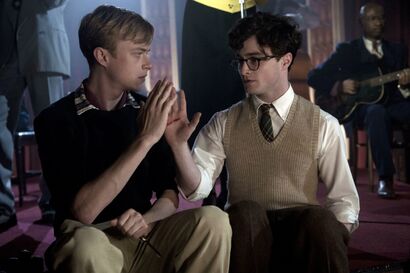
Lucien Carr (Dane DeHaan, Left) and Allen Ginsberg (Daniel Radcliffe, Right) are performing a blood oath while at a party.
Movies
By year released:
- The Invisible Man (1933)
- Rope (1948)
- In a Lonely Place (1950)
- Dial M for Murder (1954)
- Compulsion (1959)
- If... (1968)
- Suspiria (1977 or 2018)
- Another Country (1984)
- Maurice (1987)
- Withnail & I (1987)
- The Unnameable (1988)
- The Chocolate War (1988)
- True Believer (1989)
- Dead Poets Society (1989)
- Metropolitan (1990)
- Scent of a Woman (1992)
- School Ties (1992)
- Peter's Friends (1992)
- Shallow Grave (1994)
- Heavenly Creatures (1994)
- Immortal Beloved (1994)
- Total Eclipse (1995)
- Good Will Hunting (1997)
- Wilde (1997)
- The Ninth Gate (1999)
- The Talented Mr. Ripley (1999)
- Wonder Boys (2000)
- The Emperor's Club (2002)
- The Pianist (2002)
- The Dreamers (2003)
- Bright Young Things (2003)
- Mona Lisa Smile (2003)
- Capote (2005)
- Like Minds (2006)
- The Prestige (2006)
- The Great Debaters (2007)
- Brideshead Revisited (2008)
- Detachment (2011)
- Only Lovers Left Alive (2013)
- Kill Your Darlings (2013)
- The Imitation Game (2014)
- Testament of Youth (2014)
- The Riot Club (2014)
- The Theory of Everything (2014)
- Victor Frankenstein (2015)
- The Danish girl (2015)
- The Bookstore (2017)
- Phantom Thread (2017)
- Disobedience (2017)
- Colette (2018)
- Mary Shelley (2018)
- Vita & Virginia (2018)
- The Nightingale (2018)
- Tolkien (2019)
- Elisa y Marcela (2019)
- Knives Out (2019)
- Las Niñas (2020)
- Shirley (2020)
Podcasts
- Aaron Mahnke's Cabinet of Curiosities
- Dark Dice
- Lore
- Myths & Legends
- The Magnus Archives
- The Penumbra Podcast
- Prose Talk
- Unwell A Midwestern Gothic Mystery
- Unobscured
- The White Vault
TV Shows
- The Alienist
- Ares
- Deadly Class
- Elementary
- Endeavour
- Freud
- Gentleman Jack
- Hannibal
- His Dark Materials
- House of Anubis
- How To Get Away With Murder
- Mindhunter
- Murdoch Mysteries
- The Magicians
- The Nevers
- The Night Gallery
- Ordeal By Innocence
- Penny Dreadful
- Pennyworth
- Poldark
- Prodigal Son
- The Queen's Gambit
- Sherlock
- Taboo
- The Umbrella Academy
- A Series of Unfortunate Events
Anime & manga
- 91 Days
- Ancient Magus Bride
- Baccano
- Black Butler (especially the Public School Arc)
- Black Museum: The Ghost and the Lady
- Bungou Stray Dogs
- The Cat Returns
- Code Geass
- Colorful
- Doukyuusei
- From Up on Poppy Hill
- Fullmetal Alchemist
- Gankutsuou: The Count of Monte Cristo
- The Garden of Words
- Gosick
- Hyouka
- Joker Game
- Little Witch Academia
- Monster
- Moriarty the Patriot
- The Promised Neverland
- The Royal Tutor
- Saga of Tanya the Evil
- Snow White with the Red Hair
- Steamboy
- Vampire Knight
- Violet Evergarden
- Whisper of the Heart
- Tales from Earthsea
- The Wind Rises
- Your Name
Plays
- Another Country
- The Inheritance
- Spring Awakening
- Total Eclipse
Musicals
- The Count of Monte Cristo
- Dogfight
- Frankenstein: A New Musical
- Hadestown
- Jekyll & Hyde
- Light in the Plazza
- Natasha Pierre and The Great Comet of 1812
- Phantom of the Opera
- Spring Awakening
- Sweeney Todd
- Twisted
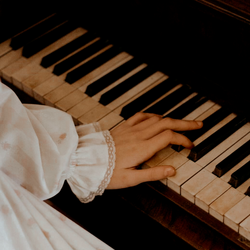
Music
The music typically associated with Dark Academia evokes the same historical and elite aesthetic through classical music, which is regarded as upper-class and traditional, and multiple people within these types of families were encouraged to pursue music to create a wide profile of skills. Specifically, the classical music used is wide-ranging, as Baroque (Bach, Vivaldi) and Romantic (Liszt, Tchaikovsky) is included. The classical music used in the aesthetic is typically in a tone more romantic, melancholy, epic, or severe, as it is played in the minor key and with piano and strings.
Contemporary alternative music is extremely popular, arguably more so than the classical, and allows for the lyrics to carry across the motifs of romance, betrayal, mystery, and crime. Classical allusions and metaphors with nature are also common techniques. There is a wide variety of instrumentation, although some common characteristics are: the use of strings or piano, slow and deep bass, and backing or echoing vocals. Tempo tends to be slower, and like in classical, has a more melancholy and contemplative tone. The genres that these songs fall into are alternative rock and indie.
Musicians
- Active Child
- Alexander Scriabin
- The Amazing Devil
- Antonio Vivaldi
- Arlie
- The Aubreys
- Barns Courtney
- The Brobecks
- Claude Debussy
- Coast Modern
- Crows in the Rain
- Dermot Kennedy
- Enigma
- Erik Satie
- Florence + the Machine
- Foxygen
- Franz Liszt
- Frédéric Chopin
- Gerhard Trede
- The Good, the Bad and the Queen
- The Gothic Archies
- Greer
- Half Alive
- Hans Zimmer
- Hozier
- Jaymes Young
- Kate Bush
- Keaton Henson
- Lana Del Rey
- Leonard Cohen
- Lola Blanc
- Lord Huron
- Lorde
- Ludwid van Beethoven
- Missio
- Mother Mother
- Mumford and Sons
- Nick Cave and the Bad Seeds
- Peter Gundry
- Pyotr Ilyich Tchaikovsky
- Sergei Rachmaninoff
- Sleeping At Last
- Sufjan Stevens
- Tally Hall
- Tamino
- Vancouver Sleep Clinic
- Wolfgang Amadeus Mozart
- The Young Veins
Albums
- Violent Things by The Brobecks
- We Are The 21st Century Ambassadors of Peace and Magic by Foxygen
- The Tragic Treasury by The Gothic Archies
- Wasteland, Baby! by Hozier
- The Magic by Lola Blanc
- In the Aeroplane Over the Sea by Neutral Milk Hotel
- Take a Vacation! by The Young Veins
Songs
- Symphony No.9 "From the new world" by Antonín Dvořák
- Icarus by Bastille
- Goodnight Socialite by The Brobecks
- Dionysus by The Buttertones
- For the Damaged Coda by Blonde Redhead
- Danse Macabre by Camille Saint-Saens
- Apocalypse by Cigarettes After Sex
- Claire de Lune, La Mer by Claude Debussy
- Piano Concerto Op.54 by Edvard Grieg
- Symphony No.8 "Unfinished" by Felix Mendelssohn
- Violin Concerto No.2 by Felix Mendelssohn
- Seven Devils, Shake It Out by Florence and the Machine
- The French Library by Franz Gordon
- Hungarian Rhapsody No.2 by Franz Liszt
- Piano Trio No.2 by Franz Schubert
- Etude No.11 by Frédéric Chopin
- Achilles Come Down by Gang of Youths
- Cherry Wine, Dinner and Diatribes, Take Me To Church, Wasteland, Baby! by Hozier
- Hungarian Dance No.1 by Johannes Brahms
- Babooshka, Cloudbusting by Kate Bush
- I Want to Feel Alive by Lighthouse and the Whaler
- The Louvre, Sober (II), Writer in the Dark by Lorde
- Piano Concerto No.3, Piano Sonata No.8 "Pathétique" by Ludwig van Beethoven
- Ann Wants to Dance by Papooz
- Lotta True Crime by Penelope Scott
- Pruit Igoe by Phillip Glass
- Feed the Machine by Poor Mans Poison
- Dr Mabuse by Propaganda
- Danse Russe (Moderato / Swan Lake Act 3) Violin Concerto by Pyotr Ilyich Tchaikovsky
- Piano Sonata No.2 by Robert Schumann
- Piano Concerto No.2, Sonata for 2 Violins Op.56 by Sergei Prokofiev
- Piano concerto No.2, Prelude No.5 by Sergei Rachmaninoff
- Tom's Diner by Suzanne Vega
- Breakout by Swing Out Sister
- Persephone by Tamino
- Theme for Bioshock 1
- Reflections by Toshifumi Hinata
- Your Woman by White Town
- Fantasia in D Minor by Wolfgang Amadeus Mozart
- Nocturnal waltz - Johannes Bornlöf
- O children - Nick Cave & The Bad Seeds
Official Aesthetics Wiki Playlist
Comics
- An Unkindness of Ravens
- Deadly Class
- Fangs
- Hooky
- Morning Glories
- Promethea
- Purple Hyacinth
- The Umbrella Academy
- Unwritten
- Your Throne

Activities
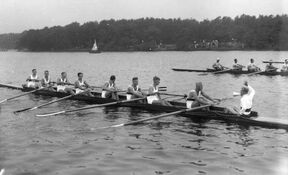
Sports
- Rowing
- Fencing
- Tennis
- Badminton
- Cricket
- Rugby
- Golf
- Swimming
- Polo
- Equestrian sports
- Running
- Javelin, discus, wrestling while covered in oil (ancient Grecian Olympics)
- Archery
- Ballet, ballroom dancing, any traditional dance works
- Pool (cue sports)

Games
- Chess
- Croquet
- Backgammon
- Cards: rummy, poker, blackjack, speed, whist, etc.
Video Games
- 1917: The Prologue
- Alicemare
- Alter Ego
- Bloodborne
- Call of Cthulhu
- Detention
- Dishonored
- GrimGrimoire
- Layers of Fear
- The Last Door Season 1
- The Metamorphosis
- The Room VR: A Dark Matter
- Rusty Lake game series
- Vampyr
- What Never Was
- Fran Bow
Crafts
- Realistic drawing
- Calligraphy
- Painting
- Bookbinding

Outings
- Museums
- Art galleries
- Places of historical interest
- Pubs, bars, and cafés
- Parks and gardens
- Places of worship
- Graveyards
- Theaters
- The opera
- Concerts
- Libraries
- Art stores
- Bookshops
- Special events
- Independent bookstores
Other
- Write essays
- Research
- Daydream
- Read
- Perform a play alone or to a pet
- Play or practice an instrument
- Fake your death
- Draw or paint something
- Reflect on the past
- Journal
- Admire cityscape/nature
Fashion
The main inspiration for Dark Academic fashion comes from 1940s prep school uniforms. Elements of the 1950s suburban American preppy look are often incorporated, such as sweater vests or sweaters worn tied over the shoulders. The main colour scheme is black, grey, beige, brown, cream, ivory, dark green, burgundy, and soft yellow. Usual fabric choices are more upscale, like cashmere, wool, and tweed, but linen and cotton are also very common. Accessories are usually minimal, like bracelets, rings, pendants, watches, cuff-links, and other dapper add-on pieces.
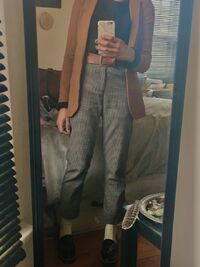
Stores & Brands
- Cottagecore Fashion (Contains elements of Dark Academia.)
- Orezoria
- Linennaive
- COS
- Storets
- Boutique 1861
- Miss Patina
- J Crew
- Aritzia
- Ralph Lauren
- Jane Marple
- Stories
- Na-kd
- Etsy - Dark Academia
Tops
- Turtlenecks
- Oxford shirts
- Fisherman's sweaters
- Sweater vests
- Light blouses
- Large polo necks
- Cable knit jumpers
- Sailor-collar shirts
- Jumpers
- Shirt dresses
- A-Line dresses
- Blousons
- Drop waist dress
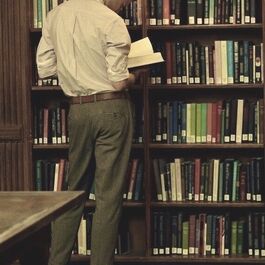
Bottoms
- Dress pants
- Ankle pants
- High rise pants
- Trousers
- Cigarette pants
- Linen shorts
- Tweed trousers
- Plaid skirts
- Mid-length or long skirts
- Pinafore
- Sailor skirts
- Pleated skirts
- Pencil skirts
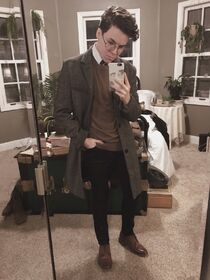
Outerwear
- Cardigans
- Blazers
- Waistcoats
- Pea coats
- Suit jackets
- Trenchcoats
- Overcoats
- Duffle coats
- Chesterfield coat
- Coat dresses
- Smock
- Dark coloured apron

Shoes
- Oxfords/brogues
- Loafers
- Wingtips
- Boat shoes
- Dr. Martens
- Mary Janes
- Chelsea Boots
Accessories
- Silver or gold jewelry
- Broaches
- Simple rings
- Satchel
- Wire-frame glasses
- Short, neat fingernails
- Belts that match your shoes
- Knee-high socks
- Watches
- Sweaters tied over the shoulders
- Undone or loosely tied ties
- Dark-colored umbrellas
- Kerchiefs/bandanas
Gallery
Resources
- LitCrit: Dark Academia
- LitCrit: Dark Academia Revisited
- Vice: Dark Academia is the witchy literary aesthetic sweeping TikTok
- Wikipedia: Dark Academia
- Vox: This week in TikTok: Are you cottagecore or more “dark academia”?
- New York Times: Academia Lives — on TikTok
Discord Servers
References
- ↑ https://lil-bit-of-a-mess.tumblr.com/post/636320046655881216/listen-i-love-dark-academia-i-really-do-it
- ↑ https://sonderstudy.tumblr.com/post/190984411818/my-two-cents-on-dark-academia
- ↑ https://sappylittlebitch.tumblr.com/post/620401404176154624/cultural-dark-academia
- ↑ https://punkenglishnerd.tumblr.com/post/189453466668/to-all-the-people-saying-can-i-still-be-a-dark
- ↑ https://ataphya.tumblr.com/post/645623340466339840/also





